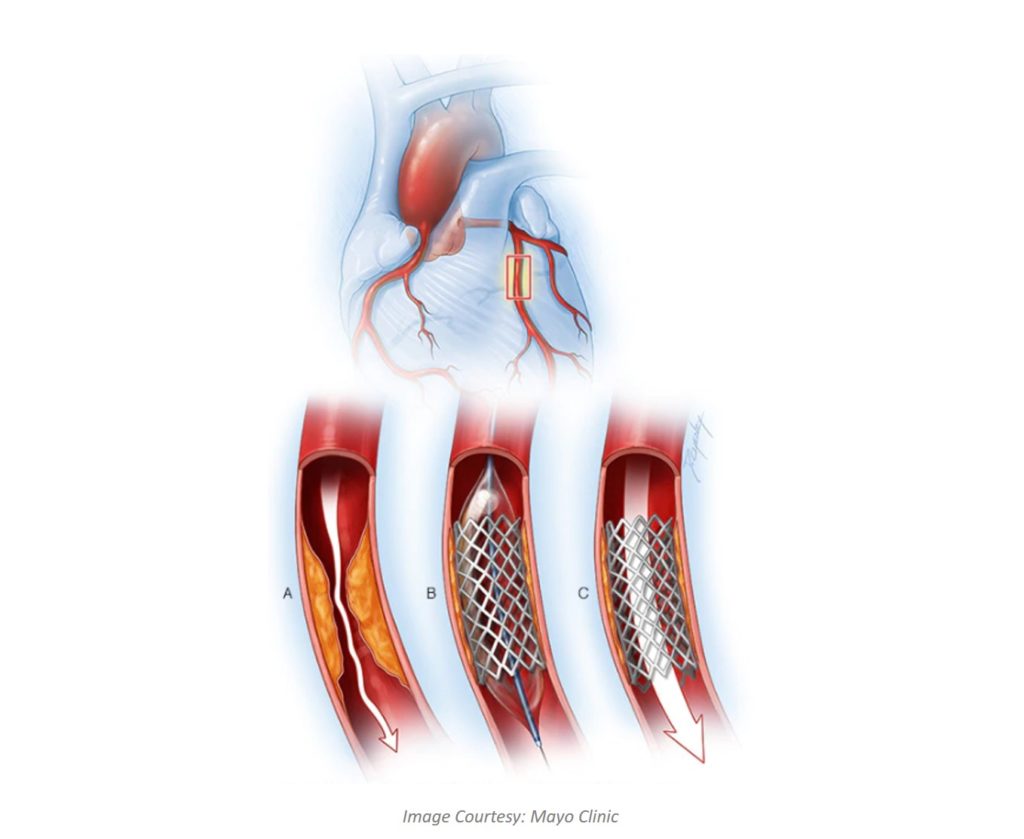OVERVIEW
Coronary angioplasty, also known as percutaneous coronary intervention, is a procedure to open clogged heart arteries. This procedure involves inserting and inflating a tiny balloon, exactly at the place where your artery is clogged, to widen the artery.
Angioplasty is often combined with the permanent placement of stent (a small wire mesh tube), to prop the artery open and decrease its chance of narrowing again. This procedure or treatment can improve symptoms of blocked arteries, such as chest pain and shortness of breath. This helps quickly open a blocked artery and reduce the amount of damage to your heart.
WHY IS IT DONE?
Angioplasty treats atherosclerosis (slow build-up of fatty plaques in your heart’s blood vessels). Your cardiologist may suggest angioplasty as treatment when medications or lifestyle changes are no more enough to improve your heart health.

Again angioplasty is not for everyone. If the main artery is narrow or heart muscle is weak, then coronary artery bypass surgery may be a better option than angioplasty. Also if you are diabetic or have multiple blockages, angioplasty is not a treatment option for you.
WHAT YOU CAN EXPECT DURING ANGIOPLASTY
Angioplasty is performed by a cardiologist (heart specialist) and a team of specialized cardiovascular nurses and technicians in a special operating room called a cardiac catheterization laboratory. This room is often called the cath lab.
A very small incision is made on the skin over a blood vessel in the leg, arm or wrist. Catheter (thin tube) is threaded through the incision and the procedure is performed. It may take up to several hours based on number of blockages and any other complications.
Very commonly angioplasty is performed through an artery in your groin. Before the procedure the area is prepared with an antiseptic solution and a sterile sheet is placed over your body. Small electrode pads are placed on your chest to monitor your heart during the procedure. You’ll be sedated but awake during the entire procedure. You’ll receive fluids, medications to relax you and blood-thinning medications through an IV catheter.
STENT PLACEMENT

Most people who have angioplasty, will also have a stent placed in their blocked artery. The stent placed inside the artery supports the walls of artery and prevent from narrowing again.
After your stent placement, you may need prolonged treatment with medications, to reduce the chance of blood clots forming on the stent.
RESULTS – AFTER ANGIOPLASTY
Angioplasty with stent increases the blood flow through previously blocked artery. Your chest pain decreases gradually. Having angioplasty and stenting doesn’t mean your heart disease goes away permanently. You will have to strictly follow a healthy lifestyle and take proper medications as prescribed by your cardiologist.
A healthy lifestyle continuity will help you live a life normal and very soon you may be able to return to your routine. There are certain things that needs to be followed very strictly after angioplasty, such as:
- Quit smoking
- Lower your cholesterol levels
- Maintain a healthy weight
- Control other conditions, such as diabetes and high blood pressure
- Get regular exercise
A successful angioplasty means you might not have to undergo a coronary artery bypass surgery. If any time your symptoms returns with chest pain or shortness of breath or any other symptoms you had earlier, contact your cardiologist immediately.











